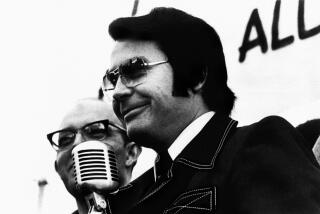Jonestown Fears Told at Abduction Hearing
- Share via
Drawing a parallel to the Jonestown cult massacre, an attorney contended Wednesday that Ginger Brown’s parents abducted the 23-year-old woman from a San Diego-based religious group partly for fear that she would be whisked from the country and face harm.
But both the young woman and leaders of Great Among the Nations, the fundamentalist ministry Brown remains devoted to, said such worries were unfounded because there were no plans to move the group from the United States.
During the second day of a preliminary hearing in Vista Municipal Court, Saul Wright, an attorney representing Brown’s father, Earle, maintained that the parents planned the May, 1988, abduction and deprogramming attempt because they “believed that overnight their daughter would be extracted from this country.”
‘Parallel to Jonestown’
Hoping to open the door for questions on its religious tenets, Wright said the group seemed “parallel to Jonestown,” where more than 900 followers of the Rev. Jim Jones perished in 1978 after the cult leader ordered them to drink a cyanide-laced fruit drink as authorities descended on their rural enclave in Guyana, South America.
Wright and other defense attorneys in the case say they would like to determine whether Great Among the Nations is a cult that posed a threat to Brown, justifying her abduction as a rescue attempt.
Judge Michael Burley, however, said Wright’s arguments amounted to “flights of fancy” and refused to allow defense attorneys to probe the doctrines and practices of the evangelical group.
“All I’ve heard so far is she has joined a rather strong religious group, but nothing so fanatical that it would put her in danger of immediate harm,” Burley said, adding that, although he sympathizes with Brown’s parents, “adult people have the right to belong to what might otherwise be called a cult.”
Deputy Dist. Atty. Gary Remple blasted Wright’s remarks as “a hysterical comparison that bears no resemblance to fact.” He added that the comparison to Jonestown seemed designed to prejudice “as many people as possible” so the case will not receive a fair hearing.
Brown, who was seized May 12, 1988, outside the Encinitas real estate office where she worked, denied Wednesday during her second day on the witness stand that either she or the group would be moving to another country.
Moreover, leaders of Great Among the Nations labeled as preposterous the arguments of Wright and other defense attorneys that the abduction and attempted deprogramming were necessary to keep Brown out of imminent danger.
“This is not a kamikaze ministry,” Benjamin Altschul, the group’s founder and leader, said in an interview outside the courtroom. “We are faithful Christians, faithful to the Bible. . . . It is ridiculous. To us, it is insane to speak of us like this.”
Altschul said he and a handful of others traveled to a small town outside Jerusalem in 1987 to investigate setting up a mission but have never planned to move Brown or others in the 16-member group out of the country.
“I told Ginger that I wish that nobody went to jail,” Altschul said. “I don’t believe her parents are criminals. I believe they are being coerced” by disgruntled parents of other group members.
Although advocates say the group is a tight-knit Christian Bible study and evangelism ministry that holds no sway over their lives, critics have characterized it as a cult whose members finance what they say is the lavish life style of Altschul.
Aside from Earle and Dorothy Rae Brown, both 57, the kidnaping charges are being pressed against Ginger Brown’s sister, Holly Rae Brown, 24; Hank Erler, 23, in whose home the young woman was allegedly held for five days, and Cliff Daniels, 34, of Los Angeles, a self-proclaimed cult deprogrammer who has publicly stated that he attempted to “rescue” Brown from the group.
Wright, Earle Brown’s attorney, said in court that the parents received letters from Ginger Brown in the weeks before the abduction suggesting that she did not want to see them anymore and didn’t “want anything to do” with them. Such statements marked a fundamental change for a young woman who once shared a remarkably close relationship with her parents, Wright said.
“They made effort after effort to contact their daughter,” Wright said. “But it became obvious that she wanted little to do with them.”
1981 Case Cited
Wright admitted, however, that he and other defense attorneys lacked direct evidence that Brown faced the sort of imminent physical danger that the judge said would be necessary to justify probing the church.
John Patterson, the attorney for Dorothy Rae Brown, suggested after Wednesday’s session, however, that a 1981 case involving a kidnaping by noted deprogrammer Ted Patrick paves the way for a defense based on Ginger Brown facing an imminent psychological danger.
Nonetheless, the attorney said the issue would likely not be pressed until the case reaches trial in Superior Court. And, even without that defense, he said, the chances a jury will convict the Browns of kidnaping their daughter seem slim.
“I don’t think a jury can look at Mr. and Mrs. Brown and decide they’re felons because they tried to help their daughter,” Patterson said. “That’s just not human nature. . . . The question is, does a parent have a right to do what they think is right for their child?”
More to Read
Sign up for Essential California
The most important California stories and recommendations in your inbox every morning.
You may occasionally receive promotional content from the Los Angeles Times.













